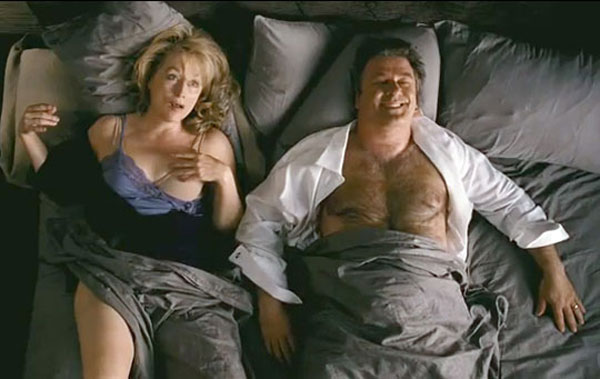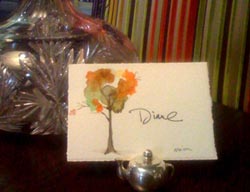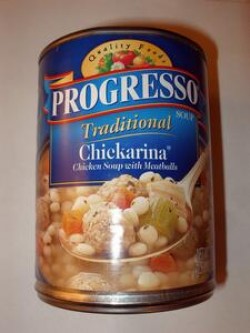Welcome to Diane’s Blog!
I’ll use this spot to chart what I enjoy and endorse, as we attempt to live a life of style in a culture of business and writing and art.
And I hope you join me; share your own stories, insights and ideas about living a creatively expressive life.
Wednesday, February 10, 2010
A few months back, in an entry in my “Eye†notebook, I wrote about entertaining, and I mentioned that one of the things I loved to use were place cards at the table. I like them for a couple of reasons. For one thing, they allow you to really think through your seating plan, so that you can try to give the table some balance or help. Sitting a shy person next to an extrovert might create more anxiety than joy – but sitting them next to someone who is kind and inquisitive and attentive, could bring them out of their shell and help them to participate in the table’s conversation.
Place cards also give you one more way to personalize the event. If you’ve brought together your table and food ideas around a theme (a particular ingredient, a country or region, a season, or an event-idea – like dinner after a gallery show or a movie) – you can amplify that very theme in the place card.
So – as encouragement – here is a set taken from my originally hand made, nature inspired place cards -- just in time for the leaves to come back to the trees -- and designed for you to make your mark.

Click on the image to download a PDF of the place cards
Evelyn and Ben, here at MEIER, have scanned them and created a sheet for you to print on your own color printer, trim and fill in the names. I’d use a good weight of black marker and write with just a little bit of flare. I use a Black Staedtler Permanent Marker. You can find them on line at:
http://www.artstuff.net/. And it's not such a bad idea to practice writing or printing the names first, by the way. Make sure you print on paper strong enough to stand, if you use a holder. I like as heavy a textured cover weight stock as your printer can manage. Or use a hole punch on the card, and tie them around napkins or the stems of wine glasses.
If you enjoy doing this, let me know – and we’ll create a whole passel of cards for you to download and use. Or show us the cards you make up on your own. We’d love to see. And it might give all of us some great ideas!

Monday, January 18, 2010
Recognizing that we have more than similar last names in common, not a few people have sent me articles and reviews about Nancy Meyers and her latest film release. They point out how her movies (Something’s Got to Give, Baby Boom, Father of the Bride, The Holiday, - and this season’s It’s Complicated), also use the device of the “House as Character†– or in the case of my novel, The Season of Second Chances, the “House as Metaphorâ€, for a life undergoing restoration. But something else has caught my eye. Every review and critique of her work, mentions the detail of Meyers’ sets and the glossy attention to material surroundings as a mark of her auteurism. Truly great directors do seem to leave their mark on every frame, but in the case of Meyers, the marked commentary on surface detail is noted with more than a snarky bit of derision.

The fact that I can still remember the French salon interiors of Last Tango in Paris (far more accurately than I can recall whether the butter was intended for Brando or Schneider) tells you something about Bertolucci’s discipline when it came to his sets. But do we hear that he is a kind of quasi-interior-designer-movie-director? We do not. Meyers’s work, like that of Nora Ephron, falls into two damning and easily shunned categories – “entertaining films that make us laughâ€, and “films made by womenâ€. You can almost see Rodney Dangerfield pulling on his sweaty collar, admitting that they don’t get no respect. And while Woody Allen may have allowed us to admit that real life is often as heart-stoppingly funny as it is heartbreaking, the insidious sexism attached to films about relationships with women, not to mention films by women goes unchallenged in review after review.
Chick-flicks, a good friend calls them. And as we sit together in a darkened movie theater and a trailer runs to a point of flirtation or romantic entanglement, if the film doesn’t redeem itself with a gun, a Nazi, or scene of heroin addiction, I know he’s going to turn to us and pronounce it, dismissively, “Chick-flickâ€. Last year the Barcelona-based director Isabel Croixet shot, in English, the best film I’d seen in years, Elegy – adapted from a novel by Philip Roth. She managed to secure spectacular performances from the cast, led by Ben Kingsley. She clearly demanded beautifully realized, supportive and accurate set design, and photographed it with marvelous camerawork – some of it hand-held by Croixet herself. Did anyone see it mentioned in the lists of best films of the year? Neither did we. It was only released to 147 theaters across America. But we both felt that if Sydney Lumet or Robert Benton had made the film, we’d have been looking at an Oscar.
If It’s Complicated is dismissed for its glossy attention to detail, it’s also trivialized as a fantasy; though Meyers has, at least in my opinion, created a credible film with two complex characters wrapped in a circumstance of giddy delight and discovery -- much the way life sometimes gives us those moments. Okay, I know it dishes out bad times too. The death of parents, friends, spouses, and sometimes of children; betrayals and divorces; the diminishing of our own strength and health; man-made wars and natural disasters; the loss of jobs and homes and status and purpose; real honest-to-god tragedies of – sometimes - epic scale. But what we also have is this – periods of time when life seems okay, when we’re cautious but willing to act upon our own bursts of optimism, and acknowledge some life-enhancing sweetness. It isn’t ridiculous that a woman like Nancy Meyer’s heroine, Jane, would find love with men the age of Alec Baldwin and Steve Martin. It isn’t even unusual.
I know, at arm’s reach, far more than a handful of women over the age of fifty who have married in the last few years. I did it myself, and I even wrote a book, The New American Wedding, that celebrates the fact that the vast majority of weddings across America are now being staged by grown-ups, long past looking for the adolescent coming-of-age event this ceremony used to be about. I can wrap my arms around dozens of couples-of-a-certain-age who find themselves newly in love and happier than they ever thought they might be. I interviewed a thousand people for that book. So don’t tell me that this is unlikely.
I’ve recently read that Nora Ephron couldn’t get funding for a film she’s been wanting to make for years. Nora Ephron. Julie&Julia -Nora- Harry-Met-Sally -Ephron. Can you believe it? Mamma Mia! passed Titanic in the UK as their biggest grossing film of all time. Still, we’re told that films for and about women are more difficult to green-light because they’re not bought by the masses of world-wide consumers who may speak no English, but who can, at least, understand the drama of action movies. This argument almost holds up, until you realize that films by many auteur/writer/directors (Judd Apatow, Spike Jonz, Wes Anderson) are not action movies. Their films don’t make as much money as Ephron or Meyers (in most cases, they make a good hundred million dollars less). And do you want to explain Adaptation to a group of non-English speaking men who are looking for action? Nora Ephron can’t get money for a film that she’s longing to do? How can this be.
What has to happen before we face sexism for what it is? And I’m not even getting started on the fact that every industry in recession-plagued America, with the exception of a handful of pharmaceuticals, appears to see 18 – 35 year olds as their target audience. Is it really possible that they don’t understand the largest population swell of the last million years is also the richest? And they wonder why they’re not making money.
On a cold Monday evening in rural New England, with a number of art-film-movie-houses and mega-seat-theaters within driving distance, Frank and I expected to be on our own in a sea of seats, watching It’s Complicated. But no. Had we arrived ten minutes later, we’d not have gotten a seat at all. The movie theater was packed with people of all ages (and both genders), who seemed to thoroughly enjoy themselves. Clearly they had no problem with the likelihood of love among the over-forty set, nor the details of the rooms that held those lovers.
The suggestion that the décor in these Meyers rooms are pie-in-the-sky, seems yet another bare-faced example of the way the critics have attempted to diminish her work. We are, after all, not looking at Castle Howard nor the art deco sets of an Astair-Rogers movie. With the exception of ocean views, the style of the houses in her films are not far beyond the grasp of many Americans. How do I know? In the worst recession of the last sixty years, the National Kitchen and Bath industry reported customers arriving in throngs with Something’s Got to Give videos in hand, hell-bent on re-creating Diane Keaton’s kitchen as their own.
We know these people. The critics know them. So do you. These are the bedrock base of Ralph Lauren’s khaki pants, Pepperidge Farm cookies, Lexus station wagons and Johnny Walker scotch. They support the libraries we visit and our local art associations. They see the movies we make and buy the books we write. They are not the Duke and Duchess of Who-Ha. They are as much a part of American culture as the Great Plains Cowboy. And when reviewers turn up their noses and suggest that Nancy Meyers has gotten all ‘precious’ in her styling, I believe they’re twisting the knife that cuts a “woman’s film†into something “less-thanâ€. It is their way of creating the “Women’s Film Ghetto†where the romance and the clothing and the set design are pointed out, as though to define a flimsy shallowness, and a lack of moral fiber.
If I recognize these Meyers characters with their familiar cable knit sweaters and their butter colored pottery, I also recognize the critic, male or female, who has bought into the idea that the things (design, fashion, home, relationships, social engagements) that have been relegated to women are no more than ephemera, that they are less important, less worthy, with infinitely less depth than the things we seem to admire in men’s work. In The Season of Second Chances, I have an older woman confront a colleague who has, like the culture I note here, deemed things of style, comfort and social intercourse, to be unworthy of her attention.
“ Where would your beloved Henry James be without style? Who is Daisy Miller without understanding the difference between the candy of Schenectady and the art on the walls of Florence? And where would Wharton be – her decorating book, her house in Lenox, her infinite notes on architecture and garden,s and most of all, the way she allowed the detail of dress or affectation to literally act as character traits. All the literature you love – all the art - this is all style.†She took a long look at me. “You’re not afraid of it at all on the page. Why does it frighten you so in the flesh?â€
I think I know why it frightens so. Because these are the things women have, for centuries, made their own, and for so long, it was the only realm in which we ruled. Must we, thirty years after the advances and the necessary questions and confusions of the Women’s Movement, denigrate the things we’ve always understood, as we also reach for the podium, the boardroom door, the scalpel or the director’s megaphone? Nancy Meyers clearly doesn’t think so. And, this season, as only
Avatar’s box-office performance surpassed
It’s Complicated, we might have to face the fact that America is neither put off by the age nor the affluence of her vision. To many of us, it just feels like home.
Thursday, November 19, 2009
In The Season of Second Chances, Teddy Hennessy often makes meals for himself and for Joy. In doing so, he shows the same kind of practical and creative talent that dazzles us in his renovation of Joy’s house. In this case, he invents a meal out of a can of soup.
“Sounds like garbage, doesn’t it?†our protagonist, Joy Harkness, asks us. “Tastes divine.†Here’s how she describes it:
“Teddy made me soup; or, to be more specific, ‘doctored me up’ some soup. It was his own invention: a sautéed onion, a can of Progresso Chicorina soup, whatever vegetable he might find in the fridge – this time it was a bag of baby spinach, a handful of angel-hair pasta, some beer, a dash of Tabasco, a squeeze of lime, with coarse black pepperâ€
If we can almost taste it, so much the better. But the real instruction is in the practicality of starting with something that already has the time element of soup-making under its belt. Progresso soup, I’ve found, doesn’t have as much of the tinny metallic, overly salted essence of canned soups. And once the beer, the lime, the Tabasco, the spinach all work their magic, the nastiness of canned soup is all but eradicated.
I’ve made a chicken pot pie with a corn bread crust – and I’ve made the corn bread from scratch. Not difficult – but not, truly, so much better than using a packaged corn bread mix and fixing any hint of ‘package’ by using orange juice instead of water, grating in some orange rind and adding a bit of nutmeg, black pepper and a dash of hot sauce into the mix.
I couldn’t be more hostile to that Sandra woman who suddenly showed up on The Food Channel and looked to be making meat loaf out of canned corned beef hash and instant pudding. But her popularity might be understood (at least a bit) by realizing just how time pressured we are.
Finding the smart short cuts to take – without compromising a level of quality and style is only one thing Teddy has to teach us. There is so much more to learn from Teddy in The Season of Second Chances. You’ll have a chance to read it when the book launches at the end of March. I’d love to hear what you’ve learned or enjoyed. Be in touch!
Thursday, November 19, 2009
Write what you know. Isn’t that the author’s golden rule? And yet, here I am, in The Season of Second Chances, writing about an academic, her work, her disciplines and her life on campus. It’s nothing like my life—which clearly has been more Mad Men than Little Men. And yet, I knew that university life would give me the kind of frame needed for readers to understand the nature of my characters, with as gentle a ramp as possible. Let me try to explain.

In The Season of Second Chances I wanted to place characters in an environment of achievement that would be familiar to most readers. University life allowed me to do this.
Even more important than the idea of a place where small town life and work would intersect, our protagonist, Joy Harkness, had to have a career most readers would be able to judge and assess. I needed Joy to have obvious authority; and pretty early in the game, I needed the reader to determine that Joy was an unreliable witness to her own life, by catching on to the fact that she was far more considerable and highly regarded in her field than she suggested. Academe gave me that chance. We all know early in the book, when she’s addressed as Dr. Harkness, that she has her PhD. From the first pages we see that she’s a published poet and biographer. And we know that one of America’s recognized leaders of academic thought has recruited Joy to Amherst. Because of our own college experience and its importance in our society, these kinds of academic hints are culturally ingrained in ways we couldn’t count on in another industry. Would you be able to judge the levels of status in the field of bio-engineering by such small hints? I wouldn’t.
And why didn’t I place Joy in my world of media and marketing? Because, unlike a life in advertising or fashion or communications, Joy had to be able to thrive in an environment where a lack of distinctive style might not be held against her. In contrast, I’ve found that style (and the consumerism that surrounds it), might be distrusted by academe, if not held in contempt. While Joy’s direction to a life of stylish self-expression does not come easily, I was aware that the women who become her mentors had to be beyond reproach in terms of their academic standing.
The scholastic world gave me a rare example of successful women who are not of a mold designed, quite specifically, to appeal to men; though appeal to men they might. They are, for the most part, sharp-tongued and sharp-witted. The best of them do not tolerate fools. They may be nurturing and devoted to their students, but they are also deeply connected to their work, their achievements and their own reputations. They think about the future of their college and of the futures of the young people they teach. We don’t often see this kind of even-handed balance in the business world. Academic life was a rich mine to me.
And perhaps as a last point, the idea of a teacher who could not nurture, who could not, in a field that is all about development, embrace her own growth, who would only face a life of intensity and passion on the pages of her beloved books; this interested me. Academic life allowed me to present this very complex character because of those wonderful, ironic, rich conflicts. What fun.





